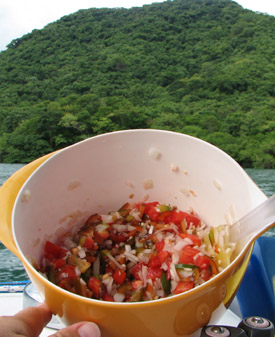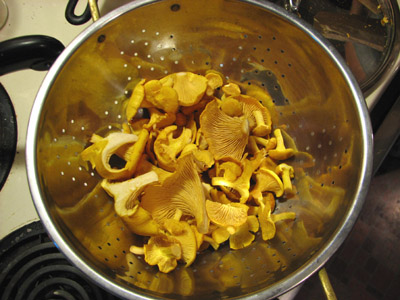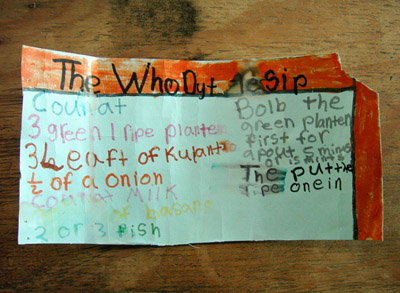Let’s Cooking: Joshua’s Pork Chop
Monday, November 13th, 2006We used to prepare this all the time when we lived on actual land. Recently, Joshua’s dad Jeff visited us on the boat and after a week of largely vegetarian dinners, a general demand for MEAT was announced by the boys. We made Joshua’s Pork Chop and, as always, it turned out pretty darned good. We never had a recipe specifying exact ingredients amounts and so we’ve always winged it—a thing that sometimes brings out the bickering on my and Joshua’s part. I have always had little regard for precision in ingredient specifications and Joshua thinks he actually remembers exactly how much of everything he put in it the last time we made it. Anyway, that’s what the wine is for.
Ingredients, more or less
* Pork! Chops of pork! I make Joshua pick these out due to an irritating squeamishness on my part around supermarket displays of dead flesh. He usually homes in on the thick ones.
* Dehydrated wild mushrooms (like porcinis); or if you are lucky enough to have fresh ones, use those. Rehydrate in hot water or broth (don’t throw out the mushroom juice when you are done though).
* White wine, maybe a half cup (sauvignon blanc, or a dry sherry—not cooking sherry either, use something you wouldn’t mind actually drinking, like a fino or amontillado. We also used Spanish brandy once). In fact, pour yourself and your cooking partner a glass in preparation for the preparation.
* Onion, chopped.
* Much garlic, sliced into little garlic sliceys.
* Balsamic vinegar (or champagne vinegar, a substance I find tastes like acetone—and not in a good way—but that Joshua loves for some crazy reason so you’ll have to battle it out on this one out). OH! I have just now received confirmation from Joshua that “Sherry vinegar’s the best.†Definitive; there you have it.
* Scant spoon of sugar, possibly. It depends upon how much balsamic you put in and how sweet it is (you can adjust for taste near the end). You might have to sneak this one in as I do for Joshua because the combination of Pork and Sugar scrambles his brain.
* Bay leaf.
* Possibly a squeeze of lime or lemon juice—again, taste it and make your decision.
* Salt and pepper to taste.
Get out your best big frying pan. Joshua is in charge of the browning of goods because he is King of the Pork Chop and so I usually just humor him on this one. Heat some oil in the pan (we always seem to use olive oil because we’re cooking Neanderthals but something that has a higher burn point is obviously preferable) and proceed to burn the shit out of all the garlic I just spent all day slicing into cute, uniform little sliceroos. Swear vociferously and demand to be handed a slotted spoon with which to fish out smoking garlic chars while I roll my eyes in I-told-you-so smugness. Luckily I always chop four extra cloves and so the process gets repeated but with a more careful eye. This time, fish out golden, crisp garlic chippy-chips from the hot oil and set aside in an attractive auxiliary kitchen dish.
Now for the pork. You must brown the pork chop; or rather sear it—a task that is nearly impossible using an alcohol stove such as we have on the Time Machine but was a SNAP when we had an antique electric stove that had only two settings: lava-red and dull brown on only one part of one spiral. Browning the pork chop, again, is Joshua Territory. I stand aside and peer around his shoulder while topping off my glass of wine. Once the browning of the pork chop is complete (be careful not to cook it all the way through, yet), set it aside for the time being.
Now, add onions to the frying pan, chopped finely and uniformly by Yours Truly and whose perfection is scoffed at by Joshua, who is simply jealous that he is incapable of such mastery of the large-bladed knife. Fight over who gets to stir. Take several sips of wine.
Once onions are well browned, a task that takes all night if you let Joshua stir because he somehow feels that the cooking process is hastened if all onions are pushed to the outskirts of the frying pan rather than spread uniformly across the center, add the mushrooms. I have to backtrack a little here: While Joshua was pushing the onions all over hell and gone in the pan, one must take a break and wind down, for example by chopping mushrooms. Remove the mushrooms from the reconstituting liquid and chop finely (I do this because the mushrooms I use are often the Trader Joes “wild†mushroom mixture and so I try to marry random mushroom flavors as best as I can). Add this to the onions in the pan and let Joshua do what he will with them while you spring into action. SPICES! Chuck in a bay leaf! Pour in the remaining mushroom juice! Grind in some pepper! Add a splash of balsamic vinegar and tell Joshua it was his favorite champagne vinegar that you threw out four months ago! Toss your own glass of wine in the pan! Sneak a taste of the sauce so far. Distract Joshua’s attention (“LOOK! A condor!!â€) whilst adding a smidge of sugar to the mix if it tastes a bit off; seize control of the wooden spoon to mix this around. I believe I’ve been known to add a pinch of thyme to this as well.
More wine. For you.
Now, add the pork chops back to the pan and reduce the heat to simmer. I generally see to it that each chop is carefully covered with a blanket of mushroom/onion mixture and that they are neatly arranged in the pan to finish cooking. This generally doesn’t take too much longer (five minutes, maybe) and while they finish up, you may cover the pan or leave it uncovered in order to reduce the sauce to an appropriate amount. Taste and adjust salt/pepper as you like. Add a squeeze of lemon or lime juice if it isn’t as tangy as you might like.
When they are finished (Joshua cuts into one and when the center is just a teeny bit pink, calls the cooking process done), remove from heat and serve, spooning the mushroom/onion mixture over the top with the juice. Sprinkle the garlic chips on top of this creation. We generally make a salad to go along with this. A Caesar salad, perhaps, using actual lettuce. Ohhhh. Good stuff.





